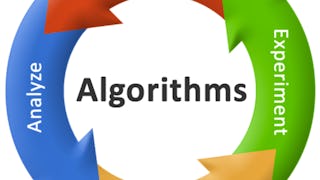Si vous avez déjà utilisé un service de navigation pour trouver l'itinéraire optimal et estimer le temps nécessaire pour arriver à destination, vous avez utilisé des algorithmes sur des graphes. Les graphes apparaissent dans diverses situations du monde réel, comme les réseaux routiers, les réseaux informatiques et, plus récemment, les réseaux sociaux ! Si vous cherchez le temps le plus rapide pour aller au travail, la manière la moins chère de connecter un ensemble d'ordinateurs en réseau ou un algorithme efficace pour trouver automatiquement des communautés et des leaders d'opinion sur Facebook, vous allez travailler avec des graphes et des algorithmes sur les graphes. Dans ce cours en ligne, vous apprendrez d'abord ce qu'est un graphe et quelles sont certaines de ses propriétés les plus importantes. Vous apprendrez ensuite plusieurs façons de parcourir les graphes et comment vous pouvez faire des choses utiles en parcourant le graphe dans un certain ordre. Nous parlerons ensuite des algorithmes du plus court chemin - des algorithmes de base à ceux qui ouvrent la voie à des algorithmes 1000000 fois plus rapides utilisés dans Google Maps et d'autres services de navigation. Vous utiliserez ces algorithmes si vous choisissez de travailler sur notre projet industriel Fast Shortest Routes. Nous terminerons par les arbres minimaux qui sont utilisés pour planifier les réseaux routiers, téléphoniques et informatiques et qui trouvent également des applications dans les algorithmes de regroupement et d'approximation.

Profitez d'une croissance illimitée avec un an de Coursera Plus pour 199 $ (régulièrement 399 $). Économisez maintenant.

Algorithmes sur les graphes
Ce cours fait partie de Spécialisation Structures de données et algorithmes



Instructeurs : Neil Rhodes
124 977 déjà inscrits
Inclus avec
(2,272 avis)
Compétences que vous acquerrez
- Catégorie : Théorie des graphes
- Catégorie : structures de données
- Catégorie : Analyse des réseaux sociaux
- Catégorie : Principes de programmation
- Catégorie : Modèle de réseau
- Catégorie : Analyse du réseau
- Catégorie : Routage de réseau
- Catégorie : Algorithmes
Détails à connaître

Ajouter à votre profil LinkedIn
1 devoir
Découvrez comment les employés des entreprises prestigieuses maîtrisent des compétences recherchées

Élaborez votre expertise du sujet
- Apprenez de nouveaux concepts auprès d'experts du secteur
- Acquérez une compréhension de base d'un sujet ou d'un outil
- Développez des compétences professionnelles avec des projets pratiques
- Obtenez un certificat professionnel partageable

Il y a 6 modules dans ce cours
Les graphes apparaissent dans diverses situations du monde réel, comme les réseaux routiers, les réseaux informatiques et, plus récemment, les réseaux sociaux ! Si vous cherchez le temps le plus rapide pour aller au travail, la façon la moins chère de connecter un ensemble d'ordinateurs en réseau ou un algorithme efficace pour trouver automatiquement les communautés et les leaders d'opinion les plus chauds sur Facebook, vous allez travailler avec des graphes et des algorithmes sur les graphes. Dans ce module, vous apprendrez comment représenter un graphe ainsi que les algorithmes de base pour décomposer les graphes en parties. Dans le devoir de programmation de ce module, vous appliquerez les algorithmes que vous avez appris pour mettre en œuvre des programmes efficaces d'exploration de labyrinthes, d'analyse de programmes d'enseignement de l'informatique et d'analyse de réseaux routiers. Au cours de la première semaine du module, nous nous concentrerons sur les graphes non dirigés.
Inclus
5 vidéos3 lectures1 devoir de programmation
Cette semaine, nous continuons à étudier les algorithmes de décomposition des graphes, mais maintenant pour les graphes dirigés.
Inclus
4 vidéos1 lecture1 devoir de programmation
Dans ce module, vous étudierez les algorithmes permettant de trouver les plus courts chemins dans les graphes. Ces algorithmes ont de nombreuses applications. Lorsque vous lancez une application de navigation sur votre smartphone, comme Google Maps ou Yandex.Navi, elle utilise ces algorithmes pour trouver l'itinéraire le plus rapide entre le travail et le domicile, entre le domicile et l'école, etc. Lorsque vous recherchez des billets d'avion, ces algorithmes sont utilisés pour trouver un itinéraire avec le minimum de changements d'avion. De manière inattendue, ces algorithmes peuvent également être utilisés pour déterminer la manière optimale d'effectuer des opérations de change, ce qui permet parfois de réaliser d'énormes bénéfices ! Nous couvrirons toutes ces applications, et vous apprendrez les algorithmes Breadth-First Search, Dijkstra's Algorithm et Bellman-Ford Algorithm. Ces algorithmes sont efficaces et jettent les bases d'algorithmes encore plus efficaces que vous apprendrez et mettrez en œuvre dans le cadre du projet Shortest Paths Capstone Project pour trouver les meilleurs itinéraires sur des cartes réelles de villes et de pays, trouver les distances entre les personnes dans les réseaux sociaux. Au final, vous serez en mesure de trouver efficacement les plus courts chemins dans n'importe quel graphe. Cette semaine, nous étudierons l'algorithme Breadth-First Search.
Inclus
8 vidéos1 lecture1 devoir de programmation
Cette semaine, nous continuons à étudier les plus courts chemins dans les graphes. Vous apprendrez l'algorithme de Dijkstra qui peut être appliqué pour trouver le chemin le plus court pour rentrer du travail. Vous apprendrez également l'algorithme de Bellman-Ford qui peut être appliqué de manière inattendue pour choisir la manière optimale d'échanger des devises. À la fin, vous serez capable de trouver efficacement les chemins les plus courts dans n'importe quel graphique.
Inclus
13 vidéos2 lectures1 devoir de programmation
Dans ce module, nous étudions le problème de l'arbre couvrant minimum. Nous aborderons deux algorithmes gourmands élégants pour ce problème : le premier est dû à Kruskal et utilise la structure de données des ensembles disjoints, le second est dû à Prim et utilise la structure de données de la file d'attente prioritaire. Dans le devoir de programmation de ce module, vous calculerez une manière optimale de construire des routes entre les villes et une manière optimale de partitionner un ensemble donné d'objets en grappes (un problème fondamental dans l'exploration de données).
Inclus
5 vidéos1 lecture1 devoir de programmation
Dans ce module, vous apprendrez les algorithmes avancés des plus courts chemins qui fonctionnent en pratique des milliers (jusqu'à 25 000) de fois plus vite que l'algorithme classique de Dijkstra sur des réseaux routiers et des graphes de réseaux sociaux du monde réel. Vous travaillerez sur un projet de programmation basé sur ces algorithmes. Vous trouverez les chemins les plus courts sur les cartes réelles de certaines régions des États-Unis et les chemins les plus courts reliant les personnes dans les réseaux sociaux. Nous vous encourageons non seulement à utiliser les idées des cours de ce module dans vos implémentations, mais aussi à trouver vos propres idées pour accélérer l'algorithme ! Nous vous encourageons à vous affronter sur les forums pour voir quelle implémentation est la plus rapide :)
Inclus
17 vidéos3 lectures1 devoir1 devoir de programmation
Obtenez un certificat professionnel
Ajoutez ce titre à votre profil LinkedIn, à votre curriculum vitae ou à votre CV. Partagez-le sur les médias sociaux et dans votre évaluation des performances.
Instructeurs



Offert par
En savoir plus sur Algorithmes

28DIGITAL
 Statut : Essai gratuit
Statut : Essai gratuitUniversity of California San Diego
 Statut : Essai gratuit
Statut : Essai gratuitUniversity of Colorado Boulder
 Statut : Essai gratuit
Statut : Essai gratuitStanford University
Pour quelles raisons les étudiants sur Coursera nous choisissent-ils pour leur carrière ?




Avis des étudiants
2 272 avis
- 5 stars
79,41 %
- 4 stars
16,63 %
- 3 stars
2,59 %
- 2 stars
0,79 %
- 1 star
0,57 %
Affichage de 3 sur 2272
Révisé le 27 févr. 2017
Fairly good course. I wish the edge cases for some of the programming assignments had some more discussions. Needed some sifting through the forums while stuck.
Révisé le 27 juin 2019
Loved the explanations and proofs. They are so explicitly told. And the discussion forum for you well assorted problems in assignment is really helpful.
Révisé le 6 janv. 2021
I've wanted to learn about Graphs and the algorithms associated with it for a long time, and I cannot imagine a better course to learn it from. Thank you?

Ouvrez de nouvelles portes avec Coursera Plus
Accès illimité à 10,000+ cours de niveau international, projets pratiques et programmes de certification prêts à l'emploi - tous inclus dans votre abonnement.
Faites progresser votre carrière avec un diplôme en ligne
Obtenez un diplôme auprès d’universités de renommée mondiale - 100 % en ligne
Rejoignez plus de 3 400 entreprises mondiales qui ont choisi Coursera pour les affaires
Améliorez les compétences de vos employés pour exceller dans l’économie numérique
Foire Aux Questions
Pour accéder aux supports de cours, aux devoirs et pour obtenir un certificat, vous devez acheter l'expérience de certificat lorsque vous vous inscrivez à un cours. Vous pouvez essayer un essai gratuit ou demander une aide financière. Le cours peut proposer l'option "Cours complet, pas de certificat". Cette option vous permet de consulter tous les supports de cours, de soumettre les évaluations requises et d'obtenir une note finale. Cela signifie également que vous ne pourrez pas acheter un certificat d'expérience.
Lorsque vous vous inscrivez au cours, vous avez accès à tous les cours de la spécialisation et vous obtenez un certificat lorsque vous terminez le travail. Votre certificat électronique sera ajouté à votre page Réalisations - de là, vous pouvez imprimer votre certificat ou l'ajouter à votre profil LinkedIn.
Oui, pour certains programmes de formation, vous pouvez demander une aide financière ou une bourse si vous n'avez pas les moyens de payer les frais d'inscription. Si une aide financière ou une bourse est disponible pour votre programme de formation, vous trouverez un lien de demande sur la page de description.
Plus de questions
Aide financière disponible,



